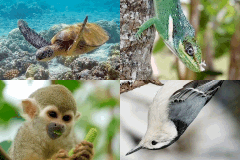AnAge entry for Pongo pygmaeus
Classification (HAGRID: 02427)
- Taxonomy
-
Kingdom: Animalia
Phylum: Chordata
Class: Mammalia (Taxon entry)
Order: Primates (Taxon entry)
Family: Hominidae
Genus: Pongo
- Species
- Pongo pygmaeus
- Common name
- Orangutan
Lifespan, ageing, and relevant traits
- Maximum longevity
- 59 years (captivity)
- Source
- ref. 671
- Sample size
- Large
- Data quality
- Acceptable
- Observations
Like other great apes, orangutans appear to be long-lived. Even in the wild, these animals might live more than 50 years. One field study conducted in the abelii subspecies estimated maximum longevity in the wild to be at least 58 years for males and at least 53 years for females without any evidence of menopause [0737]. One wild born male was about 59 years old when he died in captivity [0671]. Some authors consider Pongo pygmaeus abelii to be a separate species.
Life history traits (averages)
- No information is available on life history. Please contact us if you wish to suggest or contribute data.
Metabolism
No information on metabolism is available.
References
- [1231] Lowenstine et al. (2016), Comparative Pathology of Aging Great Apes: Bonobos, Chimpanzees, Gorillas, and Orangutans (PubMed)
- [1116] Weiss et al. (2012), Evidence for a midlife crisis in great apes consistent with the U-shape in human well-being (PubMed)
- [1136] Gomes et al. (2011), Comparative biology of mammalian telomeres: hypotheses on ancestral states and the roles of telomeres in longevity determination (PubMed)
- [0757] Anderson et al. (2008), Fertility and mortality patterns of captive Bornean and Sumatran orangutans: is there a species difference in life history? (PubMed)
- [1142] Kohler et al. (2006), Comparative mortality levels among selected species of captive animals
- [0671] Richard Weigl (2005), Longevity of Mammals in Captivity; from the Living Collections of the World
- [0737] Wich et al. (2004), Life history of wild Sumatran orangutans (Pongo abelii) (PubMed)
- [0610] Ernest (2003), Life history characteristics of placental non-volant mammals
- [0681] Peter Kappeler and Michael Pereira (2003), Primate Life Histories and Socioecology
- [0214] Maggioncalda and Sapolsky (2002), Disturbing behaviors of the orangutan (PubMed)
- [0108] Steinert et al. (2002), Telomere biology and cellular aging in nonhuman primate cells (PubMed)
- [0467] Lindenfors (2002), Sexually antagonistic selection on primate size
- [0434] Ronald Nowak (1999), Walker's Mammals of the World
- [0215] Gearing et al. (1997), beta-Amyloid (A beta) deposition in the brains of aged orangutans (PubMed)
- [0164] Holleschau and Rathbun (1994), The effects of age on glutathione peroxidase and glutathione reductase activities in lenses of Old World simians and prosimians (PubMed)
- [0455] Virginia Hayssen et al. (1993), Asdell's Patterns of Mammalian Reproduction: A Compendium of Species-Specific Data
- [0075] Selkoe et al. (1987), Conservation of brain amyloid proteins in aged mammals and humans with Alzheimer's disease (PubMed)
- [0680] Wootton (1987), The effects of body mass, phylogeny, habitat, and trophic level on mammalian age at first reproduction
- [0679] Harvey and Clutton-Brock (1985), Life-history variation in primates
- [0731] Zullinger et al. (1984), Fitting sigmoid equations to mammalian growth curves
- [0059] Tolmasoff et al. (1980), Superoxide dismutase: correlation with life-span and specific metabolic rate in primate species (PubMed)
- [0436] Cutler (1979), Evolution of human longevity: a critical overview (PubMed)
External Resources
- Integrated Taxonomic Information System
- ITIS 573083
- Animal Diversity Web
- ADW account
- Encyclopaedia of Life
- Search EOL
- NCBI Taxonomy
- Taxonomy ID 9600
- Entrez
- Search all databases
- Ageing Literature
- Search Google Scholar or Search PubMed
- Images
- Google Image search
- Internet
- Search Google

